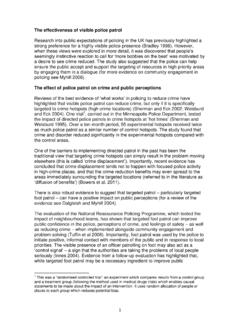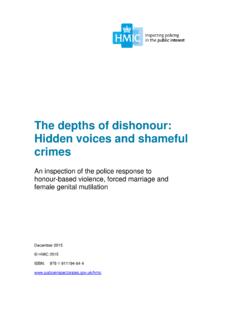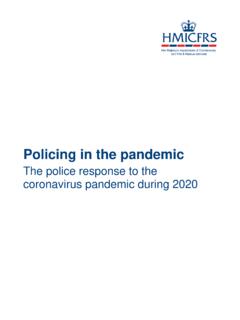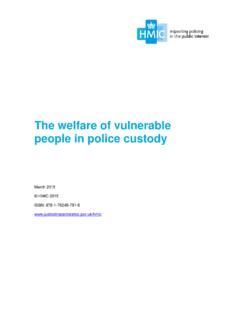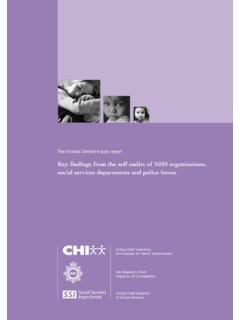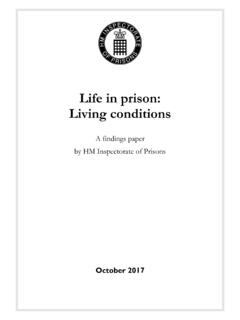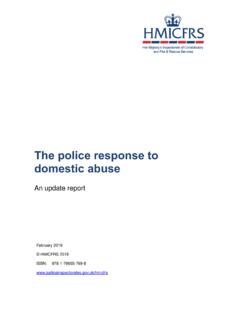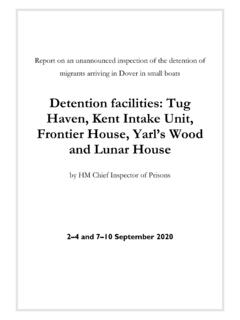Transcription of Police numbers and crime rates a rapid evidence review
1 1 Police numbers and crime rates a rapid evidence review Ben Bradford1 July 2011 Summary 1. Up until the mid-1990s there was very little evidence that increasing the number of Police officers might result in a reduction in crime or that reducing the number of officers might lead to an increase in crime . 2. However more recent studies, using more robust methodologies, have suggested that there is indeed a link between the two. 3. The weight of evidence is strengthened by the fact that the extant studies use a variety of methods. However the causal claims made by many of them are somewhat doubtful, and care should be taken when interpreting the results. 4. Most of these recent studies converge on two key findings: a. Higher levels of Police are linked to lower levels of property crime . evidence for an association between Police numbers and violent crime is weaker. b. A summary of existing studies would put the elasticity of property crime in relation to Police numbers at approximately that is, a 10 per cent increase in officers will lead to a reduction in crime of around 3 per cent (and vice versa).
2 Introduction The current reductions in public expenditure will inevitably reduce Police numbers and thus probably reduce the numbers of Police on the streets. Thus an important question to address is whether these reductions will result in more crime . Demonstrating an effect of Police numbers on crime is an issue beset with problems of causality, because there are many issues that might affect both Police numbers and the crime , such as economic cycles or social change. Furthermore, it is entirely possible - indeed likely - that more crime actually causes more Police , in the sense that all else equal, an increase in the rate of crime will lead to more officers being hired. In such cases it may look as if higher numbers of Police cause more crime , and it is important to examine temporal sequences. Three relatively recent summaries of the literature Cameron (1988), Marvell and Moody (1996) and Eck and Maguire (2000) concluded that most research finds either no link or evidence of a positive association between Police and crime levels ( more Police leads to more crime ).
3 Marvell and Moody (1996), for example, accompanied their own empirical study with a review of 36 previous papers that examined the association between Police numbers and crime rates . Only 10 of these found evidence of a negative 2 association between Police numbers and crimes of any type. Some 15, however, found a positive association between crime rates and Police numbers . This led Sherman and Eck (2002) to conclude that while there is consistent evidence that having no Police (for example during Police -strikes) significantly increases crime , the evidence of a marginal effect of increasing Police numbers on crime is weak indeed. There are however exceptions to this pattern, many of which have appeared in the literature since Sherman and Eck s (2002) review . These studies have tended to use stronger methodologies than was previously the case. They are summarised in Table 1 below.
4 Methodology This note is not intended to be an exhaustive review of research on the relationship between Police numbers and crime rates . Rather, it attempts to bring together the most relevant recent empirical studies on this issue. As such the starting point was taken to be Marvell and Moody s 1996 paper, which provided a thorough review of the literature up until that time. To collate papers from later years searches were conducted on the ISI Web of Knowledge , with search terms such a Police AND numbers AND crime . Relevant studies located in this manner were crosschecked against each other and papers they themselves referenced were added to the review . Research looking at the relationship between Police numbers and/or arrest rates and crime was counted in , and in total 13 studies, from Marvell and Moody 1996 onwards, were identified. This review is not therefore systematic, and caution should be taken in generalising from the findings discussed below.
5 However, the list of studies presented concurs with those noted in the literature reviews of the most recent papers (for example Vollaard and Konig 2009), suggesting some level of agreement as to what constitutes the currently relevant literature in this area. 3 Table 1: Summary of studies looking at the relationship between Police numbers and/or arrests and crime Study Country and Sample Method Findings Marvell and Moody 1996 US. Pooled data from 49 states and 56 cities, 1973-1992. Observational study. Multiple Time Series with fixed effects (with Granger causality test). Main explanatory variable: Police numbers per capita. Response variable(s): crime rate (incidence divided by population). Causality in both directions, with stronger effect of Police numbers on crime . This effect was much stronger at the city rather than the state level. At the state level, significant negative association between Police numbers and homicide, robbery and burglary.
6 At city level, statistical effects for homicide, robbery, burglary, larceny, auto theft and total crime all significant. Levitt 1997 US. Panel of 59 cities, 1970-1992. Observational study. Two-stage least squares using electoral cycle (election year or not) as an instrumental variable2. Main explanatory variable: sworn officers per capita. Response variable: crime rate. Increases in Police reduce crime . Estimates elasticity of crime to be : however, see McCrary s (2002) critique, which nullified these findings3. Corman and Mocan 2000 US. Monthly time series data from New York, 1970-1996. Observational study. Regression analysis with lagged effects. Main explanatory variables: number of arrests and number of Police officers. Response variable: Absolute numbers of crimes. Significant effect of arrests on murders, robberies, burglaries and motor-vehicle thefts; significant effect of Police numbers on robberies and burglaries but not on murder or motor vehicle theft.
7 Reports average elasticity of crime with respect to Police numbers as McCrary 2002 US. Panel of 59 cities, 1970-1992. Observational study. Re-analysis of Levitt (1997). Identifies problems in Levitt (1997) that effectively nullify the earlier paper s findings. 4 Levitt 2002 US. Panel of 122 cities, 1975-1995. Observational study. Two-stage least squares using number of firefighters per capita as an instrumental variable. Main explanatory variable: Police per capita. Response variables: violent crime rate and property crime rate. Negative effect of Police numbers on both violent and property crime rates . evidence is strongest for murder and robbery. Kovandzic and Sloan 2002 US. Yearly data from Florida counties, 1980-1998. Observational study. Multiple Time Series with fixed effects (with Granger causality test). Main explanatory variable: Police per capita. Response variables: crime rates . Significant and substantial impacts of Police levels on robbery, burglary and larceny and total crime (with relatively small elasticities for total crime ).
8 However no effect of Police numbers on aggravated assault or murder. Di Tella and Schargrodsky 2004 Argentina. City blocks in Buenos Aires. Natural experiment. A terrorist bomb led to Police guard being placed on every block containing a Jewish institution in Buenos Aires. A difference-in-difference approach is used to analyse the impact on car-theft in those blocks. Main explanatory variable: dummy variables representing Police presence at or near block. Response variable: Absolute number of car thefts. Find a large, negative and highly local effect of Police presence on car theft . Note that this effect is highly local and this paper is more akin to those that look at hot-spot policing . 5 Corman and Mocan 2005 US. Monthly time series data from New York, 1974-1999. Observational study. Regression analysis with lagged effects. Main explanatory variables: absolute numbers of Police officers and arrests. Response variable: absolute number of crimes.
9 Significant associations between felony arrests and murder, burglary, assault, robbery, motor-vehicle theft, grand larceny and rape. Significant associations between misdemeanor arrests and robbery, motor-vehicle theft and grand larceny. Klick and Tabarrok 2005 US. Washington DC. Natural experiment. Uses changes to terror alert status to examine potential effect on crime of Police mobilisation on high-alert days. Main explanatory variable: dummy variable representing high alert day. Response variable: Absolute number of reported crimes. Report that non-violent crime , particularly auto-theft and theft from auto was significantly reduced on high-alert days. Suggest that overall elasticity of crime in relation to Police presence of about Machin and Marie 2005 UK. Police Force Areas in England and Wales. Quasi-experiment. Used the introduction of the Street crime Initiative (SCI) in 2002 to examine the impact of increased Police expenditure on robberies.
10 Main explanatory variable: dummy representing policy on . Response variable: Robbery rate per capita. Introduction of the SCI appeared to significantly reduce the number of robberies in the areas it was introduced. Draca et al. 2008 UK. Central London Boroughs. Natural experiment. Deployment of extra Police in central London after 7/7 bombings used to examine impact on crime rates of increased Police Conclude that susceptible crime violence and sexual offences, theft and handling and robbery fell significantly in the treatment areas compared with control areas. Non-susceptible crime burglary and criminal 6 numbers in certain areas. Main explanatory variable: Police deployment (hours worked per 1,000 population). Response variable: crime rate. damage not affected. Note that this distinction seems rather arbitrary. The authors state that burglary and criminal damage are less susceptible in this context because they occur more in residential areas or at night, but provide no supporting evidence in this regard.
